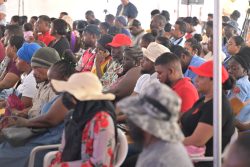(Trinidad Express) THE region—and possibly Trinidad and Tobago—are still “long overdue” for a “great earthquake” and the population must catch up on preparedness, Dr Joan Latchman, director of Seismic Research at the University of the West Indies, warned yesterday.
Though loath to be seen as attempting to predict a disaster, Latchman said historical patterns indicate earthquakes at and above the magnitude of eight on the Richter Scale have occurred every century or so in the region, and the probability of another event at that level is high.
This follows a series of smaller tremors felt in Trinidad in and around Port of Spain last week and earlier this week.
Those movements were not necessarily connected by nature to a series of up to eight small quakes felt last week in neigbouring St Lucia, which were thought to be volcanic in nature.
But here at home, the tectonic plates are moving and unlike the grinding of that other “earthquake”, Carnival, heavy movement could spell horror.
On average, the Eastern Caribbean has seen a holding pattern of quakes within seven to 7.9 every 20 to 30 years.
That pattern has stayed true, Latchman said, and was last seen in an event north of Martinique in 2007.
In the greater pattern and based on data that began just a few hundred years ago in the region, monstrous events tend to cap the centuries.
Latchman said seismology at this time cannot predict the magnitude of an event, or the date and time, but can warn about the next event in these patterns.
While the weary population may feel these warnings have been sounded for decades and the event has failed to show, it is important to remembers nature’s clock doesn’t always tick according to the human perception of time.
“The fact is that the major ones have been holding their patterns,” Latchman said.
“A great earthquake is overdue. Because of that and because of the nature of the seismic hazard, long-term preparation was required. We need to build the kind of buildings that can withstand that kind of shaking.”
She believes this country is yet to fully begin preparations to deal with a great quake—and with one of its devastating possible side-effects—the tsunami.
While the UWI Centre collaborates with the relevant state agencies, Latchman said citizens would do well to take personal preparation seriously and start with the implementing in the home of a hazard bag and disaster education.
Having a hazard bag, which should contain food and medicine, should be standard fare in all homes, not just as a precaution for earthquakes but also for all the other threats the region faces, such as tropical storms and hurricanes.
Citizens may also update themselves on earthquake survival by reading up on the UWI’s SRC website at uwiseismic.com or on its Facebook page.
Trending








